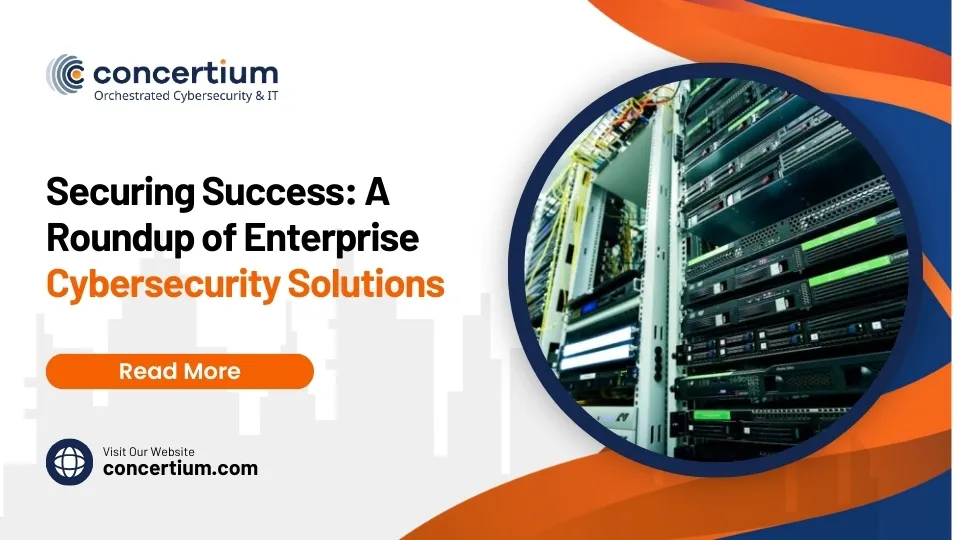Enterprise cybersecurity solutions are crucial for protecting your business from the growing menace of cyber threats. These solutions encompass a variety of tools and strategies to safeguard sensitive data, ensure regulatory compliance, and maintain trust. Here’s a quick glimpse of what they cover:
- Application Security: Protects software from attacks.
- Network Security: Secures your network traffic.
- Endpoint Security: Safeguards devices like computers and servers.
- Cloud Security: Secures your data in the cloud.
- IoT Security: Protects internet-connected devices.
Today’s tech-savvy business owners face a challenging landscape brimming with potential security vulnerabilities. For enterprises, managing cybersecurity is not just about deploying tools; it’s about implementing a robust strategy that aligns with business goals. This is where expert guidance and comprehensive solutions become vital.
In the sections ahead, we will explore the core components of these solutions, including practical technologies and novel strategies. Whether you aim to fend off phishing attacks or shield against ransomware, understanding these elements will empower you to bolster your enterprise’s defense.
Enterprise cybersecurity solutions basics:
- Cybersecurity governance frameworks
- Cybersecurity risk mitigation
- governance risk and compliance framework
Understanding Enterprise Cybersecurity Solutions
Enterprise cybersecurity solutions are a must-have for any business. They protect valuable data, ensure compliance, and help maintain trust with customers. But what exactly are these solutions, and how do they work? Let’s break it down into three main areas: technologies, tactics, and processes.
Technologies
1. Firewalls and DDoS Protection
Firewalls act as the first line of defense by monitoring and controlling incoming and outgoing network traffic. They help block unauthorized access, keeping your data safe. Distributed Denial of Service (DDoS) protection, on the other hand, ensures your systems remain operational by preventing overwhelming traffic attacks.
2. Microsegmentation and API Security
Microsegmentation divides your network into smaller, manageable segments, which helps contain breaches. Meanwhile, API security protects the interfaces that allow different software applications to communicate, ensuring that only authorized users can access sensitive data.
3. Bot Management
Bots can be used for good or evil. Effective bot management helps distinguish between helpful bots and malicious ones, preventing harmful activities like credential stuffing or data scraping.
Tactics
1. Proactive Threat Detection
Using Security Information and Event Management (SIEM) tools, enterprises can proactively track threats across their networks. These tools help identify and respond to potential threats before they can cause significant harm.
2. Incremental Data Backups
While full data backups are not always feasible, incrementally backing up critical workloads ensures that you can restore systems quickly after a security incident. This tactic minimizes downtime and data loss.
3. Disaster Recovery Planning
After a cyberattack, reviewing and improving disaster recovery processes is crucial. This includes assessing the effectiveness of data backups and tracking the speed and integrity of system restoration.
Processes
1. Security Audits and Vulnerability Assessments
Regular security audits help businesses evaluate their cybersecurity posture. Vulnerability assessments identify weak points in the system, allowing for timely remediation.
2. Employee Training
Educating employees on cybersecurity best practices is essential. Training programs should cover recognizing phishing attempts, handling sensitive information, and understanding the importance of regular software updates.
3. Compliance and Governance
Aligning cybersecurity efforts with regulatory requirements ensures that enterprises meet legal obligations. A governance framework helps manage risks and control security operations effectively.
Understanding these technologies, tactics, and processes is key to building a solid cybersecurity strategy. By combining them, enterprises can better protect themselves against a wide array of cyber threats and ensure the safety of their digital assets.
In the next section, we will dig into the key components of enterprise cybersecurity, exploring specific tools and strategies to improve your business’s security posture.
Key Components of Enterprise Cybersecurity
To build a robust security posture, businesses need to focus on key components that protect against cyber threats. Let’s explore these essential elements.
Firewalls
Think of firewalls as the security guards of your network. They monitor and control the flow of data in and out of your systems based on set security rules. Firewalls can prevent unauthorized access, keeping sensitive information safe from cyber intruders. In 2019, firewalls accounted for about 40% of network security spending, amounting to roughly $8 billion.
DDoS Protection
Distributed Denial of Service (DDoS) attacks aim to overwhelm a network, causing service disruptions. DDoS protection is crucial for maintaining operational continuity by filtering and blocking malicious traffic before it can affect your systems. This ensures your services remain accessible even during an attack.
Microsegmentation
Microsegmentation improves security by dividing a network into smaller, isolated segments. This approach limits the spread of threats, as any breach is contained within a segment. It’s like having multiple secure rooms within a building, each with its own lock, reducing the risk of widespread damage.
API Security
APIs are the bridges that connect different software systems. They are vital for data exchange but can be vulnerable to attacks. API security ensures that these connections are protected, verifying that only authorized requests are allowed. This prevents data breaches and unauthorized access to sensitive information.
Bot Management
Bots can be helpful or harmful. Good bots help with tasks like indexing websites, while bad bots perform activities like data scraping or launching attacks. Effective bot management differentiates between these, blocking malicious bots to protect your data and resources.
Each of these components plays a critical role in safeguarding your enterprise against cyber threats. By integrating them into your cybersecurity strategy, you can better protect your business and ensure its success in the digital age.
In the next section, we’ll explore some of the top enterprise cybersecurity solutions, including offerings from Concertium and industry-leading practices.
Top Enterprise Cybersecurity Solutions
When it comes to enterprise cybersecurity solutions, Concertium stands out with its comprehensive offerings. They provide a range of services designed to protect businesses from the changing landscape of cyber threats.
Concertium’s Offerings
Concertium offers end-to-end managed security services that cover everything from strategy to implementation and ongoing management. Their approach ensures that your business is protected at every stage. Some key offerings include:
- Vulnerability Risk Management: Concertium proactively identifies and addresses vulnerabilities in your systems, helping you stay ahead of potential threats.
- Incident Response Services: In the event of a breach, their team acts swiftly to minimize damage and recover your systems.
- Compliance and Consulting: They ensure your business meets industry-specific regulatory requirements, preventing costly penalties.
Industry-Leading Practices
Concertium adopts industry-leading practices to ensure the highest level of security for their clients. They emphasize a hands-on partnership approach, working closely with businesses to tailor solutions that align with their unique needs. This collaborative method helps identify potential areas for improvement and ensures solutions are effectively implemented.
Innovative Technologies
Concertium leverages innovative technologies to provide cutting-edge security solutions. For instance, they use AI-improved advanced observability to monitor and detect threats in real time. This technology allows them to identify unusual patterns and respond to potential risks before they escalate.
Moreover, their automated threat detection and eradication tools ensure that threats are neutralized quickly, reducing the risk of significant impact on your business operations.
By combining these offerings, practices, and technologies, Concertium delivers a robust cybersecurity framework that protects businesses from various cyber threats. Their solutions not only safeguard digital assets but also improve operational efficiency and resilience in the face of cyber challenges.
In the following section, we’ll dig into how these solutions help address common cybersecurity threats like phishing, malware, and ransomware.
Addressing Common Cybersecurity Threats
Cyber threats are constantly evolving, and businesses must stay vigilant. Let’s explore some of the most prevalent threats: phishing, malware, ransomware, and infrastructure vulnerabilities.
Phishing
Phishing attacks trick people into revealing sensitive information. Attackers often pose as trusted contacts, sending emails that appear legitimate. According to recent studies, most data breaches start with a social engineering attack like phishing. Training employees to recognize these scams is crucial. Building phishing awareness should be a top priority in any enterprise cybersecurity strategy.
Malware
Malware is malicious software that disrupts networks and steals data. It comes in many forms, such as trojans, worms, and spyware. Ransomware, a type of malware, locks systems until a ransom is paid. In 2018, a notable attack on Marriott used an advanced persistent threat (APT) to extract data over four years. To combat malware, companies need advanced detection systems that can identify and neutralize these threats quickly.
Ransomware
Ransomware attacks can cripple businesses by encrypting critical data and demanding payment for its release. These attacks are becoming more sophisticated, often targeting large enterprises. Concertium’s Incident Response Services are designed to act swiftly in such situations, minimizing damage and ensuring a quick recovery. Employing strategies like data backup and disaster recovery plans can also mitigate the impact of ransomware attacks.
Infrastructure Vulnerabilities
Infrastructure vulnerabilities are weaknesses in a company’s systems that attackers exploit. These can include outdated software, misconfigured networks, or weak passwords. Protecting against these vulnerabilities requires a proactive approach. Concertium’s Vulnerability Risk Management service helps identify and address these weak points before they can be exploited. Regular security audits and updates are essential to maintaining a secure infrastructure.
By understanding and addressing these common threats, businesses can better protect their digital assets. In the next section, we’ll answer some frequently asked questions about enterprise cybersecurity solutions.
Frequently Asked Questions about Enterprise Cybersecurity Solutions
What is enterprise security solutions?
Enterprise security solutions are tools and strategies designed to protect a company’s digital assets from cyber threats. These solutions safeguard applications, data, and infrastructure against malicious actors, ensuring business continuity and compliance with regulations. By implementing strong security measures, companies can defend against unauthorized access and data breaches.
What are the 3 most common cybersecurity problems in enterprises?
- Phishing: A prevalent threat where attackers trick employees into revealing sensitive information. Phishing attacks often mimic trusted contacts, making them hard to detect. Training employees to spot these scams is crucial for preventing breaches.
- CEO Spoofing: This is a type of social engineering where attackers impersonate a company’s CEO or other executives. They send fake emails to employees, requesting sensitive information or money transfers. This tactic exploits the trust and authority associated with executive positions.
- Malware: Malicious
Conclusion
At Concertium, we understand that enterprise cybersecurity solutions are not one-size-fits-all. Every business faces unique challenges and requires custom approaches to safeguard its digital assets. That’s why we offer custom solutions that are designed to fit each client’s specific needs, ensuring maximum protection with minimal disruption.
Our nearly 30 years of expertise in the cybersecurity industry have taught us the importance of staying ahead of the curve. We use our innovative Collective Coverage Suite (3CS), which includes AI-improved observability and automated threat eradication, to provide comprehensive security. This advanced observability allows us to detect potential threats quickly and respond effectively, minimizing the risk of damage to your business.
By choosing Concertium, you are investing in more than just cybersecurity. You’re investing in peace of mind, knowing that your business is protected by experts who are dedicated to your success. Let us help you guard your digital assets with our custom cybersecurity solutions, so you can focus on what really matters: growing your business.





